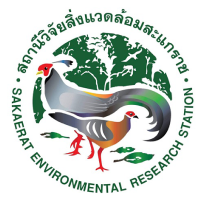Keywords :
Activity Pattern; Callosciurine Squirrels; Human Activity; Resource Use; Southeast Asia; Tropical Seasonal; Dry Forest
บทคัดย่อ :
Some squirrel species can adapt to areas of extensive human activities. However, few studies have
compared the behaviour of such squirrels in human activity areas with that in their natural forest areas in the tropics.
This study describes the activity pattern and resource use of Callosciurus finlaysonii and C. caniceps in a small
residential area located in the dry evergreen and dry dipterocarp forests in Sakaerat Biosphere Reserve, Thailand,
by using route census survey. Both species were active in the morning and evening, just as they are in the forests,
but the frequency of detection of C. finlaysonii was higher than that of C. caniceps. Intraspecific interactions were
frequently observed in C. finlaysonii; however, interspecific interactions were not observed. Callosciurus finlaysonii
used buildings and electric wires located above ground in open areas as pathways, whereas C. caniceps was not
observed in open areas. Callosciurus finlaysonii consumed a greater diversity of food items than C. caniceps,
including fruits, leaves, flowers, and seeds, whereas C. caniceps fed mainly on fruits/seeds. The present study
showed that C. finlaysonii can use human activity areas. Callosciurus finlaysonii probably use the human activity
area owing to the presence of fewer natural predators, its ability to survive in different type of environments, as
well as its wide feeding habits, and the presence of fewer competitors. However, it was observed that C. caniceps
scarcely used human modified areas.
เอกสารอ้างอิง :
Kobayashi, S., Placksanoi, J., Taksin, A., Waengsothorn, S., Aryuthaka, C., Panha, S., & Izawa, M. (2020a). Activity pattern and resource use of two Callosciurus species in different habitats in northeastern Thailand. Raffles Bulletin of Zoology, 68.



